Upgrading from an Intel Core i7-2600K: Testing Sandy Bridge in 2019
by Ian Cutress on May 10, 2019 10:30 AM EST- Posted in
- CPUs
- Intel
- Sandy Bridge
- Overclocking
- 7700K
- Coffee Lake
- i7-2600K
- 9700K

One of the most popular processors of the last decade has been the Intel Core i7-2600K. The design was revolutionary, as it offered a significant jump in single core performance, efficiency, and the top line processor was very overclockable. With the next few generations of processors from Intel being less exciting, or not giving users reasons to upgrade, and the phrase 'I'll stay with my 2600K' became ubiquitous on forums, and is even used today. For this review, we dusted off our box of old CPUs and put it in for a run through our 2019 benchmarks, both at stock and overclocked, to see if it is still a mainstream champion.
If you want to see all of our Core i7 benchmarks for each one of these CPUs, head over to anandtech.com/Bench
Why The 2600K Defined a Generation
Sit in a chair, lie back, and dream of 2010. It's a year when you looked at that old Core 2 Duo rig, or Athlon II system, and it was time for an upgrade. You had seen that Nehalem, and that the Core i7-920 was a handy overclocker and kicking some butt. It was a pleasant time, until Intel went and gave the industry a truly disruptive product whose nostalgia still rings with us today.
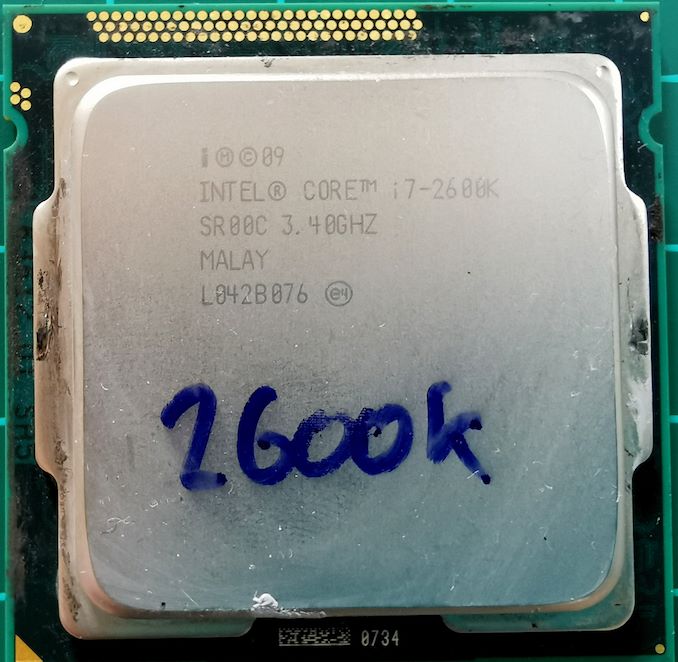

The Core i7-2600K: The Fastest Sandy Bridge CPU (until 2700K)
That product was Sandy Bridge. AnandTech scored the exclusive on the review, and the results were almost impossible to believe, for many reasons. In our results at the time, it was by far and above a leap ahead of anything else we had seen, especially given the thermal monstrosities that Pentium 4 had produced several years previous. Built on Intel’s 32nm process, the redesign of the core was a turning point in performance on x86, one which has not been felt since. It would be another 8 years for AMD to have its ‘Sandy Bridge’ (or perhaps more appropriately, a 'Conroe') moment with Ryzen. Intel managed to stand on the shoulders of its previous best product and score a Grand Slam.
In that core design, Intel shook things up considerably. One key proponent was the micro-op cache, which means that recently decoded instructions that are needed again are taken already decoded, rather than wasting power being decoded again. For Intel with Sandy Bridge, and more recently with AMD on Ryzen, the inclusion of the micro-op cache has done wonders for single threaded performance. Intel also launched into improving its simultaneous multi-threading, which Intel has branded HyperThreading for generations, slowly improving the core by making more of it dynamically allocated for threads, rather than static and potentially losing performance.
The quad-core design of the highest processor of the family on launch day, the Core i7-2600K, became a staple through Intel’s next five generations of the architecture, all the way through Ivy Bridge, Haswell, Broadwell, Skylake, and Kaby Lake. Since Sandy Bridge, while Intel has moved to smaller process nodes and taken advantage of lower power, Intel has been unable to recreate that singular jump in raw instruction throughput, with incremental 1-7% increases year on year, using that power budget to increase operational buffers, execution ports, and instruction support.
With Intel unable to recreate the uplift of Sandy Bridge, and with the core microarchitecture defining a key moment in x86 performance, users who purchased a Core i7-2600K (I had two) stayed on it for a long time. So much so in fact that a lot of people expecting another big jump became increasingly frustrated – why invest in a Kaby Lake Core i7-7700K quad-core processor at 4.7 GHz turbo when the Sandy Bridge Core i7-2600K quad core processor is still overclocked to 5.0 GHz?
(Intel’s answer was typically for power consumption, and new features like PCIe 3.0 GPUs and storage. But that didn’t sway some users.)
This is why the Core i7-2600K defined a generation. It had staying power, much to Intel’s initial delight then subsequent frustration when users wouldn’t upgrade. We are now in 2019, and appreciate that when Intel moved beyond four cores on the mainstream, if users could stomach the cost of DDR4, either upgraded to a new Intel system, or went down the AMD route. But how does the Core i7-2600K hold up to 2019 workloads and games; or perhaps even better, how does the overclocked Core i7-2600K fare?
Compare and Contrast: Sandy Bridge vs. Kaby Lake vs. Coffee Lake
Truth be told, the Core i7-2600K was not the highest grade Sandy Bridge mainstream desktop processor. Months after the 2600K launched, Intel pushed a slightly higher clocked 2700K into the market. It performed almost the same, and overclocked to a similar amount, but cost a bit more. By this time, users who had made the jump were on the 2600K, and it stuck with us.
The Core i7-2600K was a 32nm quad-core processor with HyperThreading, offering a 3.4 GHz base frequency and a 3.8 GHz turbo frequency, with a listed 95W TDP. Back then, Intel’s TDP was more representative: in our recent test for this article, we measured an 88W peak power consumption when not overclocked. The processor also came with Intel HD 3000 integrated graphics, and supported DDR3-1333 memory as standard. Intel launched the chip with a tray price of $317.
For this article, I used the second i7-2600K I purchased back when they were new. It was tested at both its out of the box frequency, and an overclocked frequency of 4.7 GHz on all cores. This is a middling conservative overclock – the best chips managed 5.0 GHz or 5.1 GHz in a daily system. In fact, I distinctly remember my first Core i7-2600K getting 5.1 GHz all-core and 5.3 GHz all-core during an overclocking event in the middle of the peak district one winter with a room temperature around 2C, where I was using a strong liquid cooler and 720mm of radiators. Unfortunately I crippled that chip over time, and now it won’t even boot at stock frequency and voltage. So we have to use my second chip, which wasn’t so great, but still a good representation of an overclocked processor. For these results, we also used overclocked memory, at DDR3-2400 C11.
It’s worth noting that since the launch of the Core i7-2600K, we have moved on from Windows 7 to Windows 10. The Core i7-2600K doesn’t even support AVX2 instructions, and wasn’t built for Windows 10, so it will be interesting to see where this plays out.
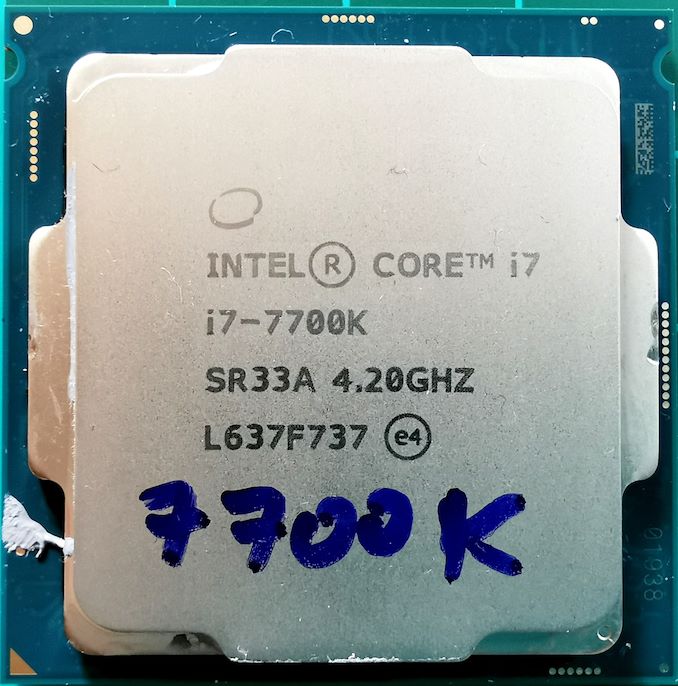
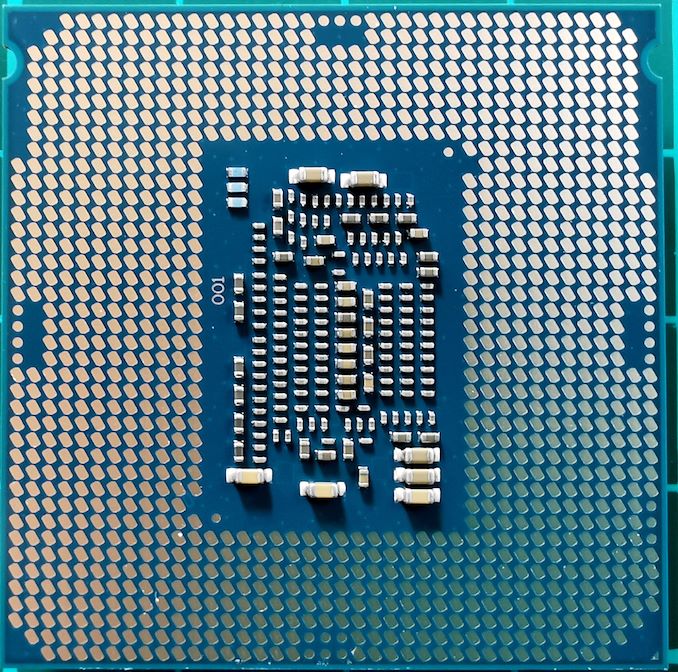
The Core i7-7700K: Intel's last Core i7 Quad Core with HyperThreading
The fastest and latest (final?) quad-core processor with HyperThreading that Intel released was the Core i7-7700K, which falls under the Kaby Lake family. This processor was built on Intel’s improved 14nm process, runs at a 4.2 GHz base frequency, and a 4.5 GHz turbo frequency. The 91W rated TDP, at stock, translated to 95W power consumption in our testing. It comes with Intel’s Gen9 HD 630 Graphics, and supports DDR4-2400 memory as standard. Intel launched the chip with a tray price of $339.
The Intel Core i7-7700K (91W) Review: The New Out-of-the-box Performance Champion
At the same time as the 7700K, Intel also launched its first overclockable dual core with hyperthreading, the Core i3-7350K. During that review, we overclocked the Core i3 and compared it directly to the out-of-the-box Core i7-2600K, trying to answer the question if Intel had managed to make a dual-core reach a similar performance to its old flagship processor. While the i3 had the upper hand in single threaded performance and memory performance, the two fewer cores ultimately made most tasks heavy work for the Core i3.
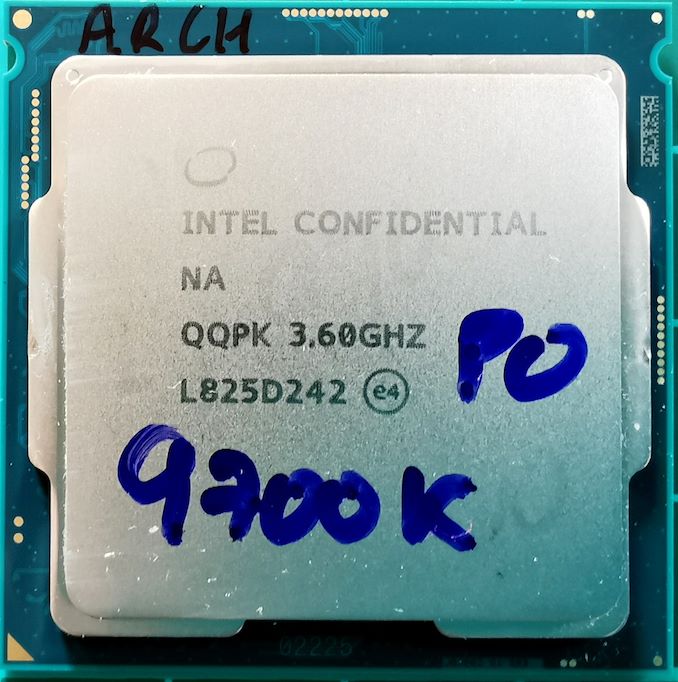
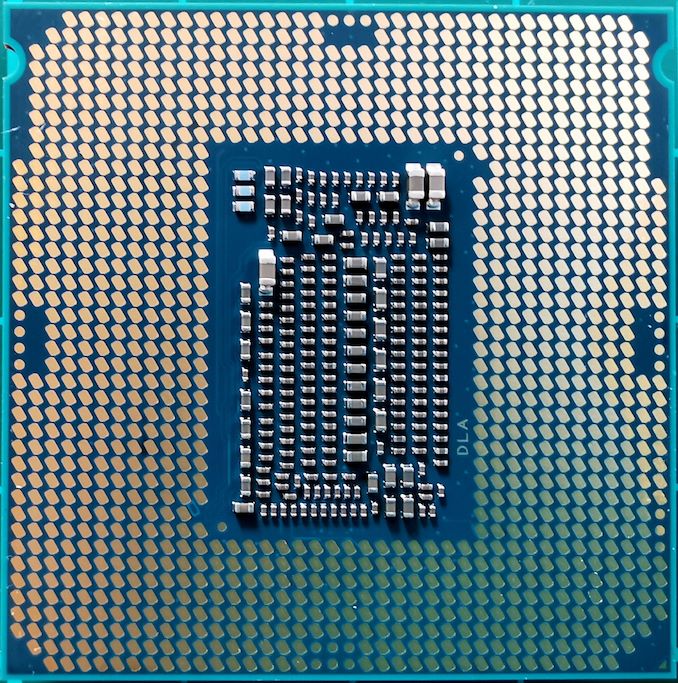
The Core i7-9700K: Intel's Latest Top Core i7 (now with 8 cores)
Our final processor for testing is the Core i7-9700K. This is not the flagship of the current Coffee Lake generation (which is the i9-9900K), but has eight cores without hyperthreading. Going for the 9900K with double the cores and threads is just a little overkill, especially when it still has a tray price of $488. By contrast, the Core i7-9700K is ‘only’ sold in bulk at $374, with a 3.6 GHz base frequency and a 4.9 GHz turbo frequency. The 95W TDP falls foul of Intel’s definition of TDP, and in a consumer motherboard will actually consume ~125W at full load. Memory support is DDR4-2666 as standard.
| Upgrading an Overclocked Intel Core i7-2600K Comparison CPUs |
||||
| Core i7-2600K |
Core i7-2600K at 4.7 GHz |
Core i7-7700K |
Core i7-9700K |
|
| Released | Jan 2011 | Jan 2011 | Jan 2017 | Oct 2018 |
| Price (1ku) | $317 | $317 | $339 | $374 |
| Process | 32nm | 32nm | 14nm | 14++ |
| uArch | Sandy Bridge | Sandy Bridge | Kaby Lake | Coffee Refresh |
| Cores | 4 plus HT | 4 plus HT | 4 plus HT | 8, no HT |
| Base Freq | 3.4 GHz | 4.7 GHz | 4.2 GHz | 3.6 GHz |
| Turbo Freq | 3.8 GHz | - | 4.5 GHz | 4.9 GHz |
| GPU Gen | 6 | 6 | 9 | 9.5 |
| GPU EUs | 12 | 12 | 24 | 24 |
| GPU Freq | 1350 | 1350 | 1150 | 1200 |
| DDR Support | DDR3-1333 | DDR3-2400 | DDR4-2400 | DDR4-2666 |
| PCIe | 2.0 x16 | 2.0 x16 | 3.0 x16 | 3.0 x16 |
| AVX | Yes | Yes | Yes | Yes |
| AVX2 | No | No | Yes | Yes |
| Thermal | Solder | Solder | Grease | Solder |
| TDP | 95 W | N/A | 91 W | 95 W |
The Core i7-2600K is stuck on DDR3 memory, has PCIe 2.0 rather than PCIe 3.0 support, and although not tested here, isn’t built for NVMe storage. It will be interesting to see just how close the overclocked results are to the Core i7-7700K in our tests, and how much of a direct uplift is seen moving to something like the Core i7-9700K.
Pages In This Review
- Tackling the Core i7-2600K in 2019
- Sandy Bridge: Inside the Core Microarchitecture
- Sandy Bridge: Outside the Core
- Test Bed and Setup
- 2018 and 2019 Benchmark Suite: Spectre and Meltdown Hardened
- CPU Performance: System Tests
- CPU Performance: Rendering Tests
- CPU Performance: Office Tests
- CPU Performance: Encoding Tests
- CPU Performance: Web and Legacy Tests
- Gaming: World of Tanks enCore
- Gaming: Final Fantasy XV
- Gaming: Civilization 6
- Gaming: Ashes Classic
- Gaming: Strange Brigade
- Gaming: Grand Theft Auto V
- Gaming: Far Cry 5
- Gaming: Shadow of the Tomb Raider
- Gaming: F1 2018
- Power Consumption
- Analyzing the Results
- Conclusions and Final Words












213 Comments
View All Comments
cwolf78 - Friday, May 10, 2019 - link
Is there any way you can do a similar comparison with the i5 CPUs? I have a 3570k OC to 4.2 GHz and its starting to struggle in some games. E.g., I can get over 60 fps in AC Odyssey for the most part, but there's all sorts of annoying spikes where the min FPS will tank for whatever reason. I'm running a GTX 970 that's OC'ed pretty close to a 980 and I don't know if it would be worth upgrading that or if my CPU would strangle anything faster. Also, whats the performance difference between an OC 3570k and a OC 3770k in modern games?RSAUser - Saturday, May 11, 2019 - link
This is mostly due to being 4 threads, that's also why I wouldn't go with anything <8 threads as you'll see it happen more and more as we all move to higher core counts.Plus Ubisoft has probably got the buggiest/worst optimized games, last one I can think of that was all right was Black Flag, mostly because they didn't change the engine and just changed the story line/map.
uibo - Friday, May 10, 2019 - link
At what voltage did you run the 2600k?abufrejoval - Friday, May 10, 2019 - link
I owned pretty much every iteration of Intel and AMD since the 80286. I pushed them all on relatives and friends to make space for the next iteration.But everything since Sandy Bridge stuck around, both because there was no reason to move them out and I had kids to serve. Mine was a 2600 no-K, because I actually wanted to test VT-d and for that you needed to use a Q-chipset and -K was not supported.
Still drives the gaming rig of one of my sons, while another has the Ivy Bridge (K this time but not delivering beyond 4 GHz). Got Haswell Xeons, 4 and 18 core, a Broadwell as Xeon-D 8 Core, Skylake in notebooks and Kaby Lakes i7-7700K in workstations and an i7-7700T in a pfSense.
Those newer i7s were really just replacing AMDs and Core-2 systems being phased out over time, not because I was hoping for extra performance: AT made it very clear for years, that that simply won’t happen anymore with silicon physics.
What I really wanted from Intel, more cores instead of a useless iGPU, more PCIe lanes, more memory channels I eventually got all from the e5-2696v3 I scored for less than $700 on eBay.
Zen simply came a little too late, a couple of Phenom II x4-6 and three generations of APUs taught me not to expect great performance nor efficiency from AMD, but at least they were budget and had become reliable (unlike the K2-K3+s).
With the family all settled and plenty of systems in all sizes and shapes the only reason to buy CPU any time soon would be to replace failed parts. And fail they just don’t, at least not the CPUs.
And then I must have 100GB or so in DDR3, which I really don't buy again as DDR4 or 5. DDR3-2400 is really just fine with Kaby Lakes.
I overclocked a bit here and there, mostly out of curiosity. But I got bitten far to often with reliability issues, when I was actually working on the machines and not playing around, so I keep them very close to stock for years now: And then it’s simply not worth the trouble, because the GPU/SSD/RAM is far more important or nothing will help anyway (Windows updates…).
Nice write-up, Ian, much appreciated and not just because it confirms my own impressions.
WasHopingForAnHonestReview - Friday, May 10, 2019 - link
Nice reply. Thanks. My 2600k is just cranking along as my darknet browsing machineRSAUser - Saturday, May 11, 2019 - link
The Zen chips actually have pretty good efficiency, I was expecting way worse before it came out since AMD hadn't been competitive in years. Zen 2 will be quite interesting, mostly due to the node shrinkage hopefully bringing way lower power envelopes and maybe cheaper CPUs, since we all need that saving for the mess that the GPU market has become.Targon - Tuesday, May 14, 2019 - link
Don't discount the significant IPC improvements that are expected from the third generation Ryzen processors(not the APUs which are Zen+ based from what I have read).evilspoons - Friday, May 10, 2019 - link
Still have a 2600k at 4.6 GHz with proper turbo support (slows down when idle). Went from GTX 680s in SLI to a single GTX 1080 and it plays most games just fine.That being said I'd love to throw in a Ryzen 7 2700X but only if one of you pays for it... 😁
rocky12345 - Friday, May 10, 2019 - link
Nice flash back review thank you. I am still on a i7 2600K@5.1GHz with 32GB DDR3@2400MHz and very tight timings. It took a while to dial in the memory since Sandy does not really support this speed gracefully like it's newer brothers & sisters do. I have 2 Samsung 512GB SSD drives in raid zero so plenty fast for windows drive and some games installed as well as 2 4TB 7200RPM hard drives.I think some of the issues you were having with the OC 4.7GHz was probably do to either memory not 100% stable or the CPU may have just been at the edge of stable because it probably wanted just a tad bit more voltage. on my system I had random problems when it was new due to memory timings and finding just the right voltage for the CPU. After getting all of that dialed in my system is pretty much 100% stable with 5.1GHz and DDR3@2400MHz and has been running this way since 2011.
So going from these charts for the gaming results & mine at 5.1GHz would place my system faster than the i7 7700K stock and a slightly over clocked one as well. Though I am 100% sure a i7 7700K fully overclocked would get better FPS since their IPC is like what 10%-12% better than a Sandy clock for clock and then if you throw in AVX2 My Sandy would get hammered.
I am going to be upgrading my system this summer not because I feel my system is slow but more because I know because of it's age that something could fail such as main board or CPU and it would be costly to try to replace either of those so time for the big upgrade soon. I probably will move this system to do secondary duties and have it as a back up gaming system or there for my friends to use when we get to together for a gaming session. I have not fully decided which way to go but am leaning towards maybe AMD Ryzen with Zen 2 and at least 8/16 CPU and maybe a 12/24 CPU if they release more than 8 cores on the main stream desktops.
isthisavailable - Friday, May 10, 2019 - link
Still running a i5 3450. Runs fine and maintains 60 FPS for 95% of the time.